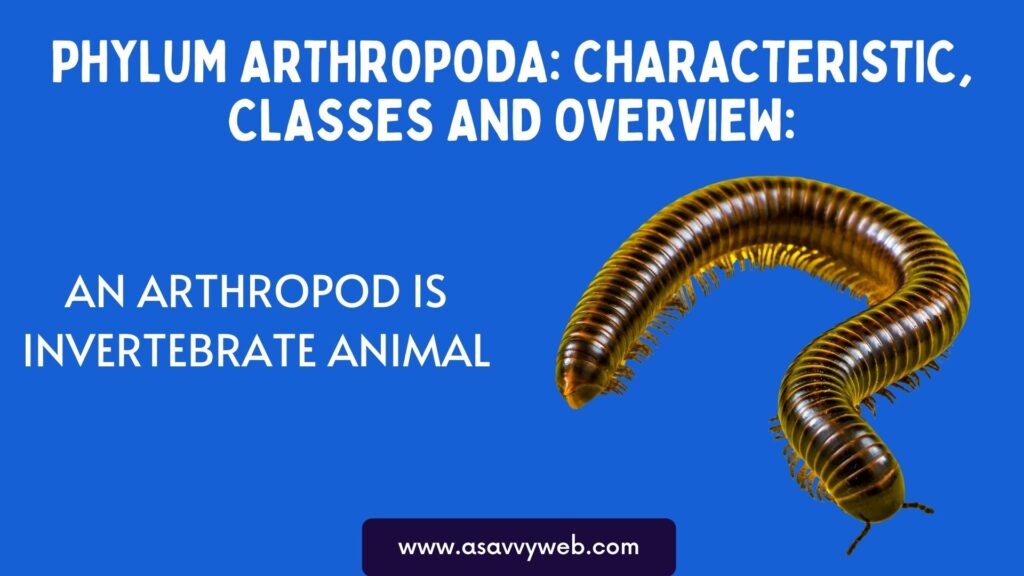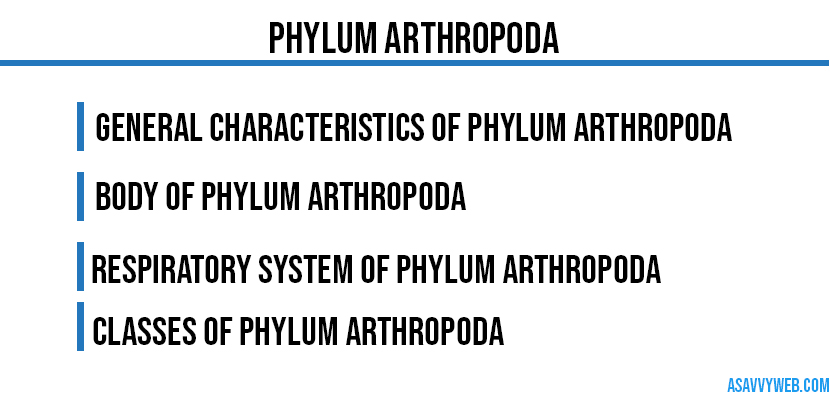An Arthropod is invertebrate animal
| Phylum: | Arthropoda; Lar, 1904 |
| Scientific name: | Arthropoda |
| Kingdom: | Animalia |
| Rank: | Phylum |
| Higher classification: | Ecdysozoa |

General Characteristics of Phylum Arthropoda
Of All living Phyla, Phylum Arthropoda is the largest phylum with more than 90000 species (9 Lakh species) and this is the moist successfully and the oldest biological group.
These are the most successful group of animals and they outnumber all other animals in population strength and their body is segmented and is covered by hard exoskeleton which is made of chitin. During growth the exoskeleton is shed (moulting of ecdysis).
The legs or paired appendages are jointed. The head region has a pair of prominent compound eyes. Each compound eye is made up of several photoreceptor sub units called Ommatidia.
Phylum Arthropoda have an open circulatory system without vessels and the body cavity is filled with a fluid called haemolymph. Such body cavity is known as haemocoel.
These are unisexual, exhibiting sexual dimorphism. The young forms produced are invariably called the larvae. The larvae undergo metamorphosis and develop into adults. They occur in all habitats, almost every where in the world and they are Bilaterally symmetrical segmented animals.
Body of Phylum Arthropoda
The body of Phylum Arthropoda (Arthopdes) are is divided into head and a trunk. The trunk divided in to a thorax and an abdomen as originate in the case of insects.
In some animals like crabs the thorax fuses with the head and thus the body is divided in to cephalothorax and the abdomen.
The body of Phylum Arthropoda is covered with extra skeleton which is made of chitin which is very hard and these exoskeleton is shed periodically in the course of their growth and this process is known as ecdysis or moulting.
Phylum Arthropoda have open circulatory system and their body contains cavity called Haemocoel which surrounds the body organs and the heart pumps blood into Haemocoel so that the blood immerses (arranges in set of groups) the organs.
Respiratory System of Phylum Arthropoda:
The respiratory organs of Phylum Arthropoda are gills in aquatic forms, while trachea or book lungs in terrestrial forms. The excretion takes place coelomoducts or by Malpighian tubules.
Nervous System of Phylum Arthropoda:
The nervous system of Phylum Arthropoda is well developed and is similar the one found in annelids and it consists of cerebral ganglion attached to the pair of ventral nerve cord with the help of a nerve ring surrounding the pharynx.
Endocrine System of Phylum Arthropoda:
Phylum Arthropoda or Arthropods also show the presence of endocrine system and insects communicate through pheromones which are secreted by the endocrine system.
Sexes of Phylum Arthropoda:
In Phylum Arthropoda the sexes are separate and they are oviparous in nature which means they lay eggs. Scorpions are an exception to this fact as they are viviparous.
Phylum Arthropoda Organs:
Phylum Arthropoda have well developed organs such as antenna to perceive sense of touch a statocyst and organ of balance and taste locators are located in their feet and photoreceptors in the eye to perceive light.
Classes of Phylum Arthropoda:
This Phylum comprises five Classes, Class Onychophora: It includes small worm like Peripatus. It shows Annelidan and Arthropoda characters. Hence this may be considered as a connecting link between the two groups. Phylum Arthropoda is divided in to classes:
| Crustacea |
| Chilopoda |
| Diplopoda |
| Insecta |
| Arachnida |
Class Crustacea of Phylum Arthropoda:
Class Crustacea of Phylum Arthropoda includes a wide range of animals mostly aquatic and they show great variation in form and the presence of carapace (exoskeleton) and a compound eye.
Examples of Class Crustacea:
Few of the examples are Damhnia (water flea) and Astacus (Cray fish).
Class Chilopoda of Phylum Arthropoda:
Class Chilopoda includes centipedes and their body consists numerous pairs of legs and there is always one pair for segment and they also show the presence of pair of poison claws.
Class Diplopoda of Phylum Arthropoda:
Class Diplopoda includes millipedes and their body consist numerous leg-bearing segments with two pairs of legs per segment.
Class Insecta of Phylum Arthropoda:
Class insecta is the largest group of terrestrial animals and they occupy every possible habitat, they have an extra ability to adapt to changes in the environment.
Class insecta mouth parts such as mandibles and maxillae are modified for various modes of feeding. Class insecta show the presence of pupal stage i.e an incubation stage in their life cycle and this stage helps them to survive during the unfavourable environmental condition and some very examples of insects are ants, cockroaches, mosquitoes and butterflies.
Class Arachnida of Phylum Arthropoda:
Arachnida is the last class under the phylum Arthropoda includes spiders and scorpions and known for 8 legged arthropods and their body is separated into a cephalothorax and abdomen. Arachnids breath in with book lungs or trachea and most of the flying insects act as pollinating agents and helps plant to cross pollinate.
Arthropods such as crabs, prawns, serve as such as delicious see food which people like to eat. But several insects are serious pests that destroy crops worth billions of rupees. Termites cause damage to timber, houses and furniture.
Parasites such as lice, fleas and mosquitos, spread diseases in humans and animals, for examples mosquitoes are vectors of malaria.
The last phylum that comes under invertebrates is Echinodermata.
Crabs, Mosquitoes, Spiders, Mites, Insects, Centipedes and Millipedes
Yes! largest phylum with more than 90000 species (9 Lakh species)
Body is segmented and is covered by hard exoskeleton which is made of chitin
Phylum Arthropoda body divided into head and a trunk and the trunk divided in to thorax and abdomen as originate in the case of insects

